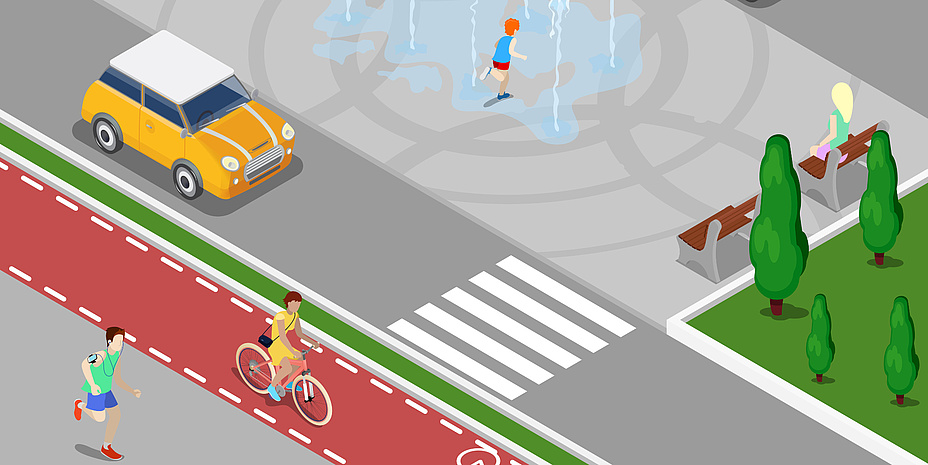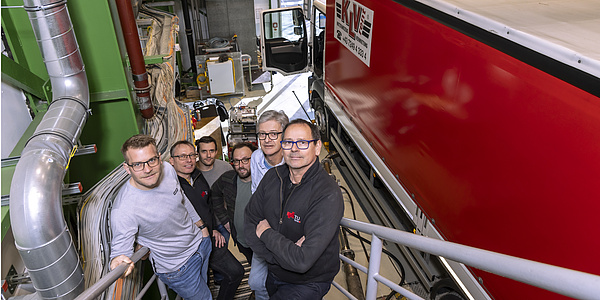“We Should Rethink the Hierarchy in Mobility”

News + Stories: Many people don’t want to give up their cars because they need and like them. Are there ways to positively motivate people to switch to other forms of mobility?
Aglaée Degros: I lived in Rotterdam for around 15 years - people didn’t give up their cars there either. However, the car isn’t right outside the door in the morning, but in a garage a little further away. Right outside the door is a bus or tram stop, and the cycling infrastructure is safe enough for children to cycle to school and sports on their own. This does not mean that people are not allowed to use their car. But cars shouldn’t automatically be used for every journey just because they are literally in front of the door, because there are no alternatives or because you think other forms of mobility are unsafe. That is really important. As a mother, I can see the big difference here. In Rotterdam, my older son used his bike to go to school, to sport facilities or to meet his friends. Here in Graz, a mother is more in the position of a taxi driver who has to drive her children everywhere because it’s not safe to send them out on their own and public transport is not available everywhere (especially on the fringes of the city).
Another issue is commuter traffic to the cities, as more and more people are moving to the outskirts. Are there approaches in urban planning to reduce these traffic flows?
Degros: A very good study by the University of Vienna has shown that the next big challenge in urbanism is the question of how to deal with the suburbs. Suburbs per se generate a lot of car traffic. To solve the problem of mobility from the outskirts into the centre of the city, we will have to invest a great deal in public transport. But what does this mean for the people who have chosen to live in the city centre? Do they agree that a lot of the money they pay in taxes should be spent on the outskirts of the city, which in many cities is the area where people have a lot of money anyway? The study has shown very well that in this case, we have to look at the periphery in a completely different way – as a place that also attracts people from the centre to visit. If you’re going to build a transport option for the suburban community, it would be good if there was also a traffic flow in the other direction.
This raises the question of whether the suburbs will become a place for leisure in the future. It might be good to have a place for children to play football outside the city centre, or to start walks into the country side. Therefore, this means that public transport shouldn’t be developed for people travelling into the city exclusively - it also has to be available for people who live in the city and want to take part in activities in the periphery. But there are other forms of mobility as well, such as e-bikes, which enable people to easily cover a radius of 15 kilometres. For a city like Graz, that’s not bad at all and could improve the traffic situation. That is why the province of Styria is now investing quite a lot in a cycling campaign – not only in the city centres, but also in the outlying districts.
The focus of planning should not be on cars. It should start with the needs of pedestrians, then look at bicycles, then at public transport and only then at cars.
Are there any trends in urban development, especially when it comes to transport and mobility?
Degros: The Institute of Urbanism took part in a major competition in Luxembourg to which ten consortia from all over the world were invited. The result was a manifesto setting out what we should change in our current way of planning in order to achieve a sustainable transition of our living spaces. One of the aspects considered was mobility. The aim was to reverse the existing hierarchy in mobility. The focus of planning should not be on cars. It should start with the needs of pedestrians, then look at bicycles, then at public transport and only then at cars. So, the car is not excluded, but you just have to think a little differently in the planning process. When doing this, the first priority would be a safe environment for walking to school. A good network of cycle paths, both locally and regionally, would also be important.
Another important point was the mix of functions that we try to take into account in our planning. This is based on the idea of the 15-minute city by Carlos Moreno from the Sorbonne. Following this approach, all the public facilities you regularly need in your neighbourhood are reachable on foot in 15 minutes, such as a kindergarten, a school, shopping facilities, a small park, etc. This concept reduces the need for basic mobility.
This interview is part of the TU Graz Dossier "Cities in a Changing Climate". You can find further Dossiers at www.tugraz.at/en/go/dossiers
You mentioned the hierarchies of mobility forms. Is it also a question of which form gets how much space?
Degros: Yes, at the moment that’s exactly the burning issue. In theory, everyone here agrees that pedestrians need to be protected and that a design accomplishing this would also be better for the environment. Moreover, this would certainly be the cheapest form of mobility. But then there’s the limited street space, that we have to divide and organize.
In Zurich, some streets were redesigned. The planners looked at the space starting from the facade of the buildings and allocated how much was needed for pedestrians, bicycles and trees – and the rest was left for cars. They developed a mobility concept that works and is the right size for active forms of mobility. It’s a question of mindset and it takes political courage to support this.
Of course, we have to address the concerns and fears of the residents. If a concept stipulates that all cars in a certain area are to be removed, alternatives must be offered and communicated – for example an under used garage in the surrounding area. In addition, efficient public transport is needed.
You mentioned the 15-minute city. What advantages does such a city offer?
Degros: In theory, this principle combines mobility, urbanism and the time factor. For me, linking these three together is the intelligent core of Carlos Moreno’s concept. You have everything you need for your daily life within a 15-minute walk. This not only promotes sustainable mobility, but also a lively neighbourhood. However, critics of the 15-minute city concept wondered whether there was a risk that cities would turn into a kind of agglomeration of several small villages - that the individual areas would no longer open up to their surroundings and to each other. But I don’t see the city as something centralised that is divided into zones - instead I see it as a collection of smaller centres. That’s why there’s nothing village-like about it for me. It’s more about decentralising and having sub-centres, which would be a very good concept for Graz. There would be St. Leonhard or Andritz as a small sub-centre, for example, and that could certainly work. In St. Leonhard, there was a farmers’ market near the kindergarten where you could see young and old people meeting. That was quite nice. Also, not everything has to be reachable within the 15 minutes. Of course, you should sometimes travel further afield to take advantage of offers in other parts of the city - the sub centres do have to be linked by longer distance walkways and cycle routes.
I recommend taking a look at Beacon Hill in Boston, because it is very close to my idea of an ideal city
If you could design a city from scratch without having to take anything into account, what would it be like – especially in terms of mobility?
Degros: I would never plan something from scratch. I think it’s much nicer to transform a city with existing buildings and infrastructure. We organised an excursion with our students to the new administrative capital of Egypt. Six million people are supposed to live there, the city was planned and built from scratch. It lacks soul, history but also durability. The entire concept is organised around car mobility - you have to cover many kilometres to get from one point to another. It’s all connected by eight-lane roads, it looks like a nightmare. In a compact city it is of course much easier to establish active mobility than in a sprawling city like that.
I would do exactly the opposite. I would re-use buildings - it is good to start from something that already exists. I would make everything very compact. I would then pay great attention to the distance between blocks and districts. But high density does not necessarily mean that there have to be high-rise buildings – that is a misbelief. I recommend taking a look at Beacon Hill in Boston, because it is very close to my idea of an ideal city. In Boston, everything is flat except for one hill. There used to be several hills, but they removed everything and used the earth for the harbour. Only one hill remained, and on it there are buildings with a completely different typology than in the rest of the city. These are classic blocks with a fairly high density, but they are never higher than five or six storeys. Everything is compact there, but with beautiful streets full of greenery. For me, this is a very good example of successful urbanisation.
Another example of an urban concept that I really like is La Ferme du Rail in Paris. This is a very sustainable project which could serve as a pilot project for a city based on green corridors. Not only has the former railway infrastructure been transformed into a green ring, which is fantastic for walking and cycling, but in addition, a building has been created that is a combination of an affordable residential building and a greenhouse for crops. That’s why it’s called the railway farm (Ferme du Rail) - because they grow what you can buy on the promenade right there. The project also houses a restaurant and a small retail shop. It’s a nice place to live because it’s all made of wood, existing building infrastructure is re-used and the neighbourhood is well connected to the vegetation. This matches with what I would recommend for the redevelopment of cities: stay compact so that the most important things are within a short distance, integrate green spaces and re-use what is already there to create a city where everyone can live well, within the limits of the planet.
Kontakt
Aglaée DEGROS
Univ.-Prof. Arch.
TU Graz | Institute of Urbanism
Phone: +43 316 873 6283
a.degros@tugraz.at



